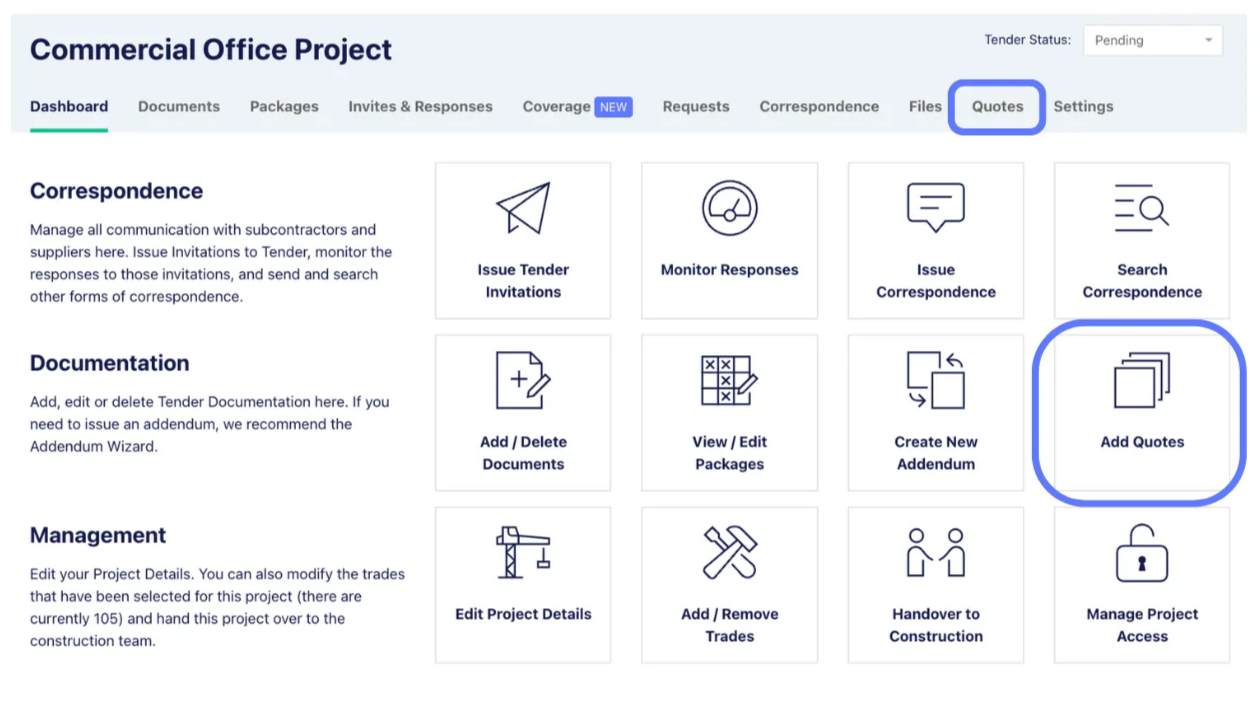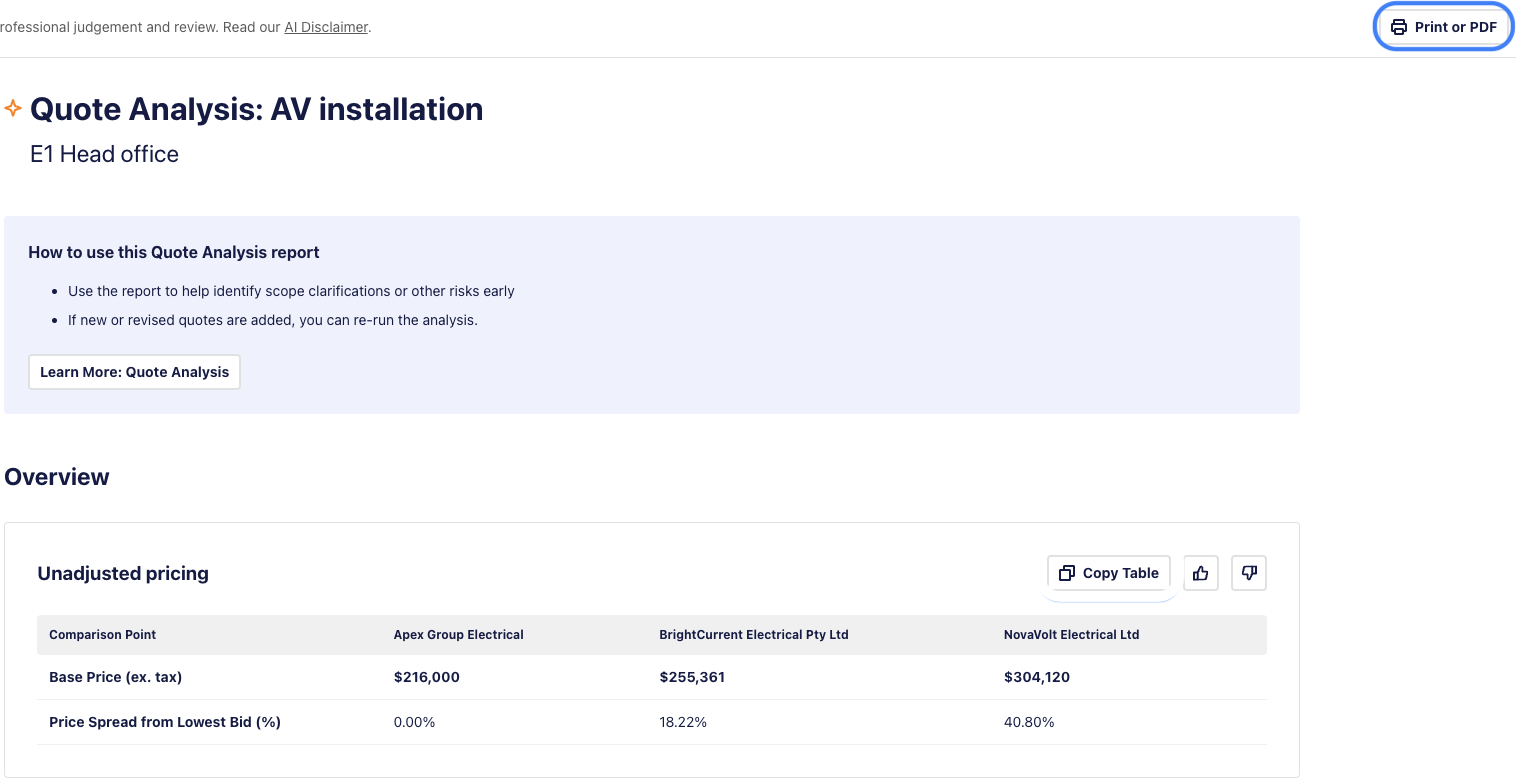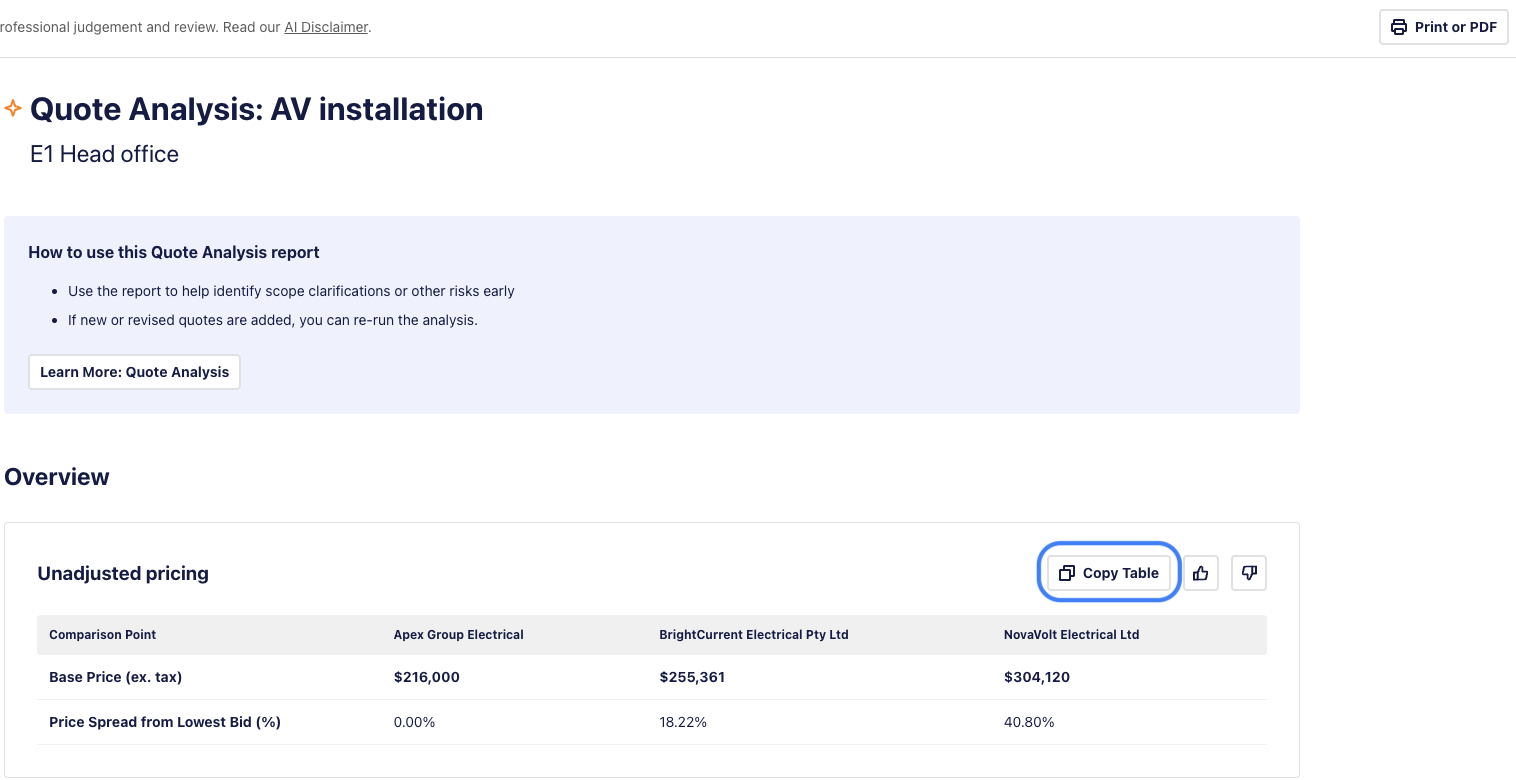Quote Analysis is a feature that uses artificial intelligence to automatically read and compare two to five subcontractor or supplier quotes within a single trade package. It automatically scans your quotes to highlight key risks, discrepancies, and scope differences in minutes, allowing you to focus on what matters most: making informed, confident pricing decisions.
How to Get the Most Out of Quote Analysis
Quote Analysis complements your professional expertise, not replaces it. To integrate it seamlessly into your workflow, we recommend these best practices:
- Get an Early Start: Don't wait for all quotes to arrive. Run an analysis on the first few to get an early read on inclusions, exclusions, and potential scope gaps.
- Prioritise Your Follow-ups: Use the analysis to quickly identify which subcontractors and suppliers need clarification. The tool helps you spot ambiguities or missing items to build your RFI list faster.
- Perform a Final Sense-Check: Before finalising your bid-levelling, use the tool as a final check to ensure all key risks and clarifications have been addressed.
What Your Analysis Report Includes
Before you run your first analysis, here’s what you'll receive. The report is broken down into clear, actionable sections.
Icons
In the report icons are used as quick visual indicators. Refer to the legend at the top of each section for a clear definition of what each icon represents.
Here is an example of the icons and their definitions for the Inclusions located in the Scope Breakdown section of the report:

Understanding the sections within the quote analysis report
Overview
- Unadjusted Pricing: A side-by-side price comparison of the quotes, sorted by amount, that includes the calculated spread from the lowest bid to help you quickly understand the variance.
- Suggested Clarifications: A list of suggested questions for each subcontractor and supplier, categorised by topic to help get started or to confirm your own conclusions.
Scope breakdown
- Inclusions & Exclusions: A comprehensive comparison of scope, organised under clear headings. The report includes additional comments for detail and highlights important risk factors related to exclusions.
Additional insights (Beta)
- Optional Costs / Schedule of Rates (Beta): A summary of any optional costs, alternative pricing, or schedules of rates included in the quotes.
How to Run a Quote Analysis Report
Things to note before generating a quote analysis report
To ensure your analysis runs smoothly, please check the following:
- One Analysis Per Package: Analysis is run on a per-package basis. You cannot analyse quotes from different packages together. Make sure you've uploaded all the quotes you want to analyse first.
- Quote Limit: You can analyse up to 5 quotes.
- File Size: Each file must be no larger than 10MB.
- File Types:
- Supported: We currently accept PDF, TXT, MD, HTML, and CSV files.
- Unsupported: Other formats like Microsoft Word (.DOCX), Excel (.XLSX), and email files (.MSG, .EML) are not currently supported. Please convert these to a supported format like PDF before uploading.
Step 1: Prepare Your Quotes
Quotes can be submitted directly by subcontractors and suppliers or uploaded by you and your team if received from an email. If you have uploaded a quote ensure you assign it to a specific trade Package (e.g., "Plumbing," "Electrical"). The analysis will not work on quotes left as 'Uncategorised' or in the 'Full Set'.
Step 2: Navigate to the Quotes Tab
Once in the project navigate to the quotes sections of the project via the Dashboard icon or the Quotes tab.

Step 3: Locate the Package and Start the Analysis
Locate the trade package to be analysed and click the ‘Analyse Quotes’ button to begin.

Viewing vs. Re-running an Analysis
If a report already exists for a package, the button will change. Here is what the options mean:
- View Analysis: This opens the most recently generated report. It will not include any new quotes you may have uploaded since the last analysis was run.
- Re-run Analysis: This generates a completely new report. It will process all quotes currently in the package (up to the 5-quote limit) and will overwrite the previous analysis report. Choose this option if you have added, removed, or replaced quotes. If there are more than five quotes to a package, you must select which ones to include.

Reviewing Your Results & Providing Feedback
The analysis provides a powerful first pass, but its real value comes when combined with your professional expertise. As you review the report, compare the AI findings against your own assessment of the quotes and ask yourself the following questions:
- Was any piece of information inaccurate?
- What other information would help?
- Did it help you compare and level quotes better or faster?
Sharing and Exporting the Analysis Results
- Sharing: You can share the report by copying the unique web address (URL) from your browser. Please note: Only team members who have been granted access to this specific project in E1 will be able to view the link.
- Exporting: You can export the quote analysis via the ‘Print or PDF’ button at the top right of the report.

You can also copy the table of data and paste into a spreadsheet. Click the ‘Copy Table’ button which is located in the Overview section, then paste the copied data into your spreadsheet.

A Crucial Note on AI, Accuracy, and Trust
Quote Analysis is an assistant, but it's essential to understand its role as a decision-support tool, not a decision-making tool.
The final call and responsibility for the tender always rests with your team’s expertise.